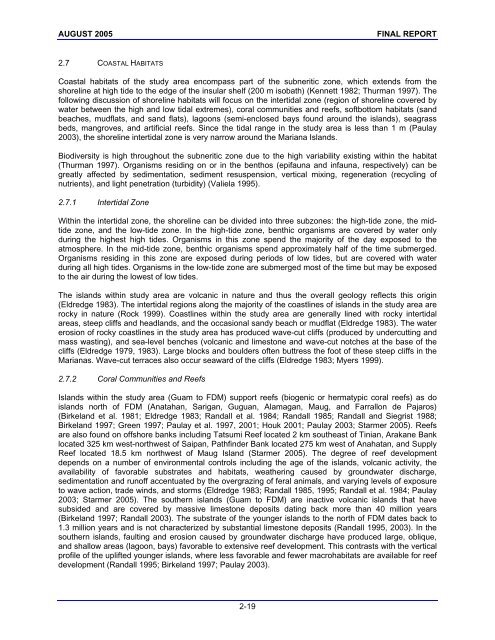Marine Resources Assessment for the Marianas Operating ... - SPREP
Marine Resources Assessment for the Marianas Operating ... - SPREP
Marine Resources Assessment for the Marianas Operating ... - SPREP
You also want an ePaper? Increase the reach of your titles
YUMPU automatically turns print PDFs into web optimized ePapers that Google loves.
AUGUST 2005 FINAL REPORT<br />
2.7 COASTAL HABITATS<br />
Coastal habitats of <strong>the</strong> study area encompass part of <strong>the</strong> subneritic zone, which extends from <strong>the</strong><br />
shoreline at high tide to <strong>the</strong> edge of <strong>the</strong> insular shelf (200 m isobath) (Kennett 1982; Thurman 1997). The<br />
following discussion of shoreline habitats will focus on <strong>the</strong> intertidal zone (region of shoreline covered by<br />
water between <strong>the</strong> high and low tidal extremes), coral communities and reefs, softbottom habitats (sand<br />
beaches, mudflats, and sand flats), lagoons (semi-enclosed bays found around <strong>the</strong> islands), seagrass<br />
beds, mangroves, and artificial reefs. Since <strong>the</strong> tidal range in <strong>the</strong> study area is less than 1 m (Paulay<br />
2003), <strong>the</strong> shoreline intertidal zone is very narrow around <strong>the</strong> Mariana Islands.<br />
Biodiversity is high throughout <strong>the</strong> subneritic zone due to <strong>the</strong> high variability existing within <strong>the</strong> habitat<br />
(Thurman 1997). Organisms residing on or in <strong>the</strong> benthos (epifauna and infauna, respectively) can be<br />
greatly affected by sedimentation, sediment resuspension, vertical mixing, regeneration (recycling of<br />
nutrients), and light penetration (turbidity) (Valiela 1995).<br />
2.7.1 Intertidal Zone<br />
Within <strong>the</strong> intertidal zone, <strong>the</strong> shoreline can be divided into three subzones: <strong>the</strong> high-tide zone, <strong>the</strong> midtide<br />
zone, and <strong>the</strong> low-tide zone. In <strong>the</strong> high-tide zone, benthic organisms are covered by water only<br />
during <strong>the</strong> highest high tides. Organisms in this zone spend <strong>the</strong> majority of <strong>the</strong> day exposed to <strong>the</strong><br />
atmosphere. In <strong>the</strong> mid-tide zone, benthic organisms spend approximately half of <strong>the</strong> time submerged.<br />
Organisms residing in this zone are exposed during periods of low tides, but are covered with water<br />
during all high tides. Organisms in <strong>the</strong> low-tide zone are submerged most of <strong>the</strong> time but may be exposed<br />
to <strong>the</strong> air during <strong>the</strong> lowest of low tides.<br />
The islands within study area are volcanic in nature and thus <strong>the</strong> overall geology reflects this origin<br />
(Eldredge 1983). The intertidal regions along <strong>the</strong> majority of <strong>the</strong> coastlines of islands in <strong>the</strong> study area are<br />
rocky in nature (Rock 1999). Coastlines within <strong>the</strong> study area are generally lined with rocky intertidal<br />
areas, steep cliffs and headlands, and <strong>the</strong> occasional sandy beach or mudflat (Eldredge 1983). The water<br />
erosion of rocky coastlines in <strong>the</strong> study area has produced wave-cut cliffs (produced by undercutting and<br />
mass wasting), and sea-level benches (volcanic and limestone and wave-cut notches at <strong>the</strong> base of <strong>the</strong><br />
cliffs (Eldredge 1979, 1983). Large blocks and boulders often buttress <strong>the</strong> foot of <strong>the</strong>se steep cliffs in <strong>the</strong><br />
<strong>Marianas</strong>. Wave-cut terraces also occur seaward of <strong>the</strong> cliffs (Eldredge 1983; Myers 1999).<br />
2.7.2 Coral Communities and Reefs<br />
Islands within <strong>the</strong> study area (Guam to FDM) support reefs (biogenic or hermatypic coral reefs) as do<br />
islands north of FDM (Anatahan, Sarigan, Guguan, Alamagan, Maug, and Farrallon de Pajaros)<br />
(Birkeland et al. 1981; Eldredge 1983; Randall et al. 1984; Randall 1985; Randall and Siegrist 1988;<br />
Birkeland 1997; Green 1997; Paulay et al. 1997, 2001; Houk 2001; Paulay 2003; Starmer 2005). Reefs<br />
are also found on offshore banks including Tatsumi Reef located 2 km sou<strong>the</strong>ast of Tinian, Arakane Bank<br />
located 325 km west-northwest of Saipan, Pathfinder Bank located 275 km west of Anahatan, and Supply<br />
Reef located 18.5 km northwest of Maug Island (Starmer 2005). The degree of reef development<br />
depends on a number of environmental controls including <strong>the</strong> age of <strong>the</strong> islands, volcanic activity, <strong>the</strong><br />
availability of favorable substrates and habitats, wea<strong>the</strong>ring caused by groundwater discharge,<br />
sedimentation and runoff accentuated by <strong>the</strong> overgrazing of feral animals, and varying levels of exposure<br />
to wave action, trade winds, and storms (Eldredge 1983; Randall 1985, 1995; Randall et al. 1984; Paulay<br />
2003; Starmer 2005). The sou<strong>the</strong>rn islands (Guam to FDM) are inactive volcanic islands that have<br />
subsided and are covered by massive limestone deposits dating back more than 40 million years<br />
(Birkeland 1997; Randall 2003). The substrate of <strong>the</strong> younger islands to <strong>the</strong> north of FDM dates back to<br />
1.3 million years and is not characterized by substantial limestone deposits (Randall 1995, 2003). In <strong>the</strong><br />
sou<strong>the</strong>rn islands, faulting and erosion caused by groundwater discharge have produced large, oblique,<br />
and shallow areas (lagoon, bays) favorable to extensive reef development. This contrasts with <strong>the</strong> vertical<br />
profile of <strong>the</strong> uplifted younger islands, where less favorable and fewer macrohabitats are available <strong>for</strong> reef<br />
development (Randall 1995; Birkeland 1997; Paulay 2003).<br />
2-19
















